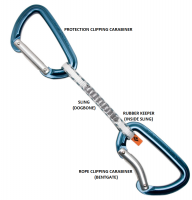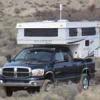My experience from this scenario: I drove the camper home with cross winds on the highway going around 55mph to 60mph. The camper being top heavy with the crosswinds blowing and being installed in a bed with a plastic bedliner was a white knuckle ride for me. My truck with its stock leaf springs was bottom heavy with the front of the truck slightly facing upward. The windy condition was rocking my truck around and I stayed in the slow lane except to get around the semi-trucks. I didn't like the fact that the plastic bedliner made the bed slippery for the camper with the heavy winds and highway speed. I should have bought the rubber mat before I purchased the camper and brought it home. This made me feel very uncomfortable on the ride home as I didn't want the scenario of that picture of the previous post with a camper dropped on the road way.
Fortunately for me, the ratchet straps that I brought with me, held the camper in place without the need to retighten the straps during the trip home. After my first drive home with that camper, I've already bought a set of Torklift tiedowns. My next upgrades are to remove the plastic bedliner, have a sprayed in bed liner, buy a Dee Zee heavy weight rubber bed mat to go under the camper, and a set of Deaver springs and possibly the Firestone Ride Rite air bags for my truck. I won't be judgemental of what other people use on their truck camper rigs, but my IMHO, ratchets straps are good for temporary use for transporting a camper if you have don't have proper camper tiedowns or as a backup if your tiedowns fail. I wouldn't want to use them as a permanent installation on a camper that weighs a half ton or more.
Edited by Hamer95USA, 27 May 2017 - 07:25 PM.




















